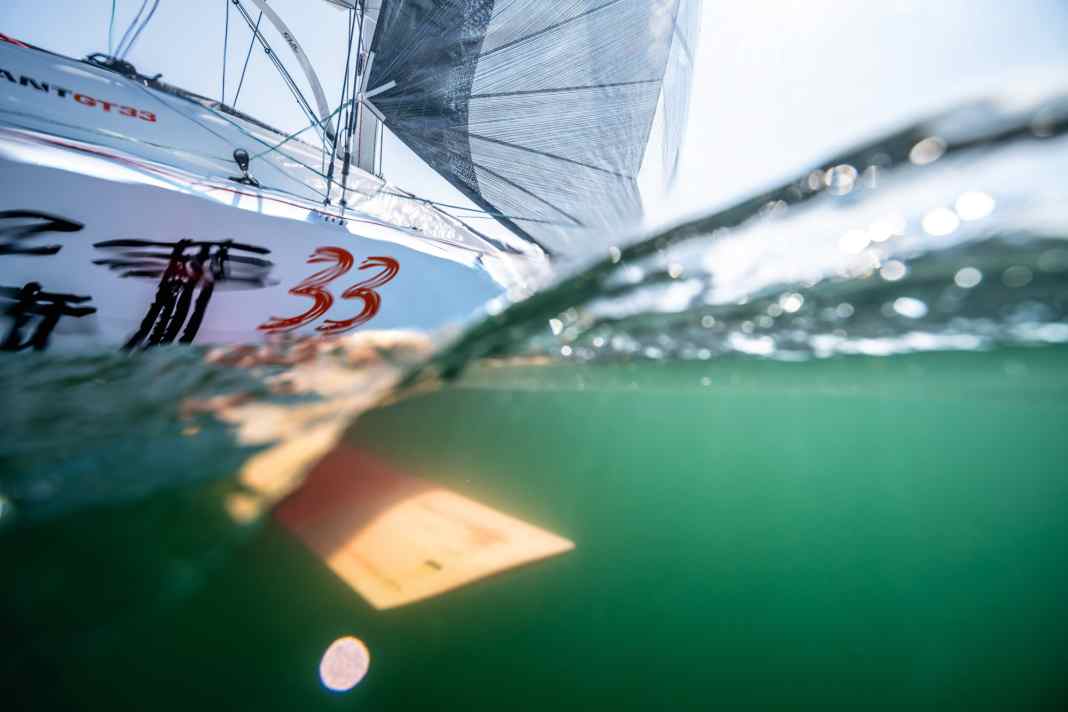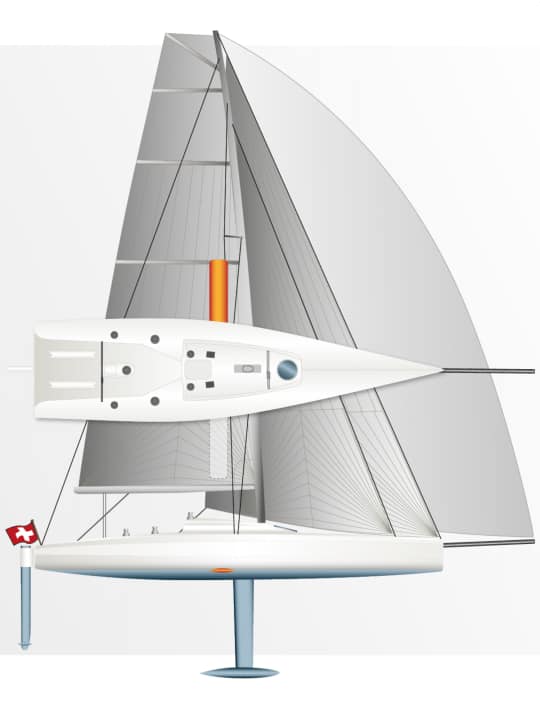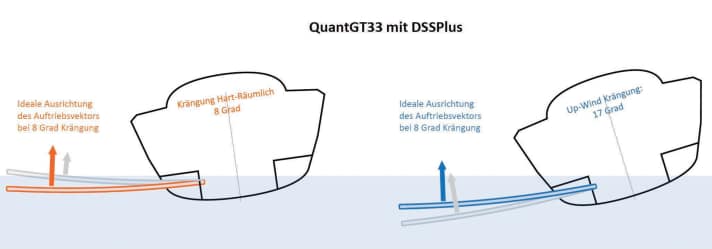





The Swiss Michael Aeppli is a busy man - especially when it comes to making sailing boats fast and even faster. For many years, the Zurich native has therefore been working with foil technology and, in particular, with DSS. The abbreviation stands for Dynamic Stability System. The principle: an asymmetrical wing profile is extended downwind of the waterline, where it generates dynamic lift. Just like an aeroplane wing - only in the water.
The upward force on the long lever provides an additional righting moment, i.e. less heeling. In return, boats with DSS technology can manage with less keel ballast, or with less crew weight on the high edge. A simple, efficient and ingenious concept. For more on how DSS works, the latest developments and the differences to foil technology, see page 82 onwards.
Together with the designer and DSS expert Hugh Welbourn from England, Aeppli built a 28-foot test boat with a Dynamic Stability System 15 years ago and subsequently fuelled the development with various new construction projects under the Quant Boats brand. With the innovative Quant 23 foiler, the lateral thinkers Welbourn and Aeppli have even advanced the development of the DSS principle to a fully airworthy sports boat with a keel (YACHT 19/2015 test). Ten years ago, this was still a minor revolution.
With the new GT33, Quant Boats has now added another boat to its ambitious small series of foil-assisted sports boats. With a hull length of ten metres, it is now the Swiss brand's largest boat. Built in England entirely from carbon fibre sandwich with epoxy resin, the prototype was completed in autumn 2024 and is now undergoing extensive testing. It is not yet clear where the GT 33 will ultimately be built in series.
The centrepiece of the Quant GT 33 is of course the DSS foil. The lightly secured wing is housed in a closed box laminated transversely into the hull and can be retracted and extended directly from the cockpit on both sides of the hull using sheet pulls. At 2.5 metres, the wing is just as long as the boat is wide.
The large Quant is not for beginners. The DSS grand piano and the rest of the technology require a great deal of expertise.
If the profile is fixed in the middle, which can be checked via sight glasses in the structure, manoeuvring in the harbour is easy. However, caution is required when manoeuvring into the box, as the wing still protrudes quite a bit on both sides of the unusually far-retracted waterline. The slim hull shape, the ready-to-sail total weight of just over one tonne, the fully retractable lifting keel and the equally flexible rudder blade make it easy to transport the GT 33 on a conventional road trailer. The foil does not need to be removed for this.
For the test, the YACHT test editors were only able to try out all the advantages of DSS technology on the GT 33 to a limited extent. The wind was too light on the test day on Lake Zurich in Switzerland, with a maximum force of just six knots. However, with half the wind below Code Zero and a speed of around seven knots, the effect of the foil is already clearly noticeable. The heel decreases, the pressure increases and the display on the Speedo rises. The lift on the wing not only increases the righting moment, but also provides lift for the entire system. This means that the faster the boat sails, the greater the resulting upward force. This leads to a lower immersion depth, a smaller wetted surface and therefore less resistance in the water.
Measurement results of the Quant GT 33



Designer Hugh Welbourn calculates that the deep profile of the DSS wing on the GT 33 can produce over a tonne of lift when fully extended and at a speed through the water of 15 knots. Theoretically, the boat could therefore take off at this speed, i.e. foil. However, the stretched shape of the DSS wing with its low immersion depth does not allow this. The Quant GT 33 is not intended to fly at all, just to be fast. When there is very little wind and the boat speed is below the DSS effective speed, the wing is simply pulled out to windward to avoid resistance downwind.
This may look strange, but it doesn't really bother. And the crew can enjoy the benefits of a slim and light boat. However, handling the DSS profile on the Quant GT 33 is demanding and requires skill and practice. In order to shift the slightly curved wing from one side to the other when tacking or jibing, the boat must be slow so that the pull-out mechanism works well and with little friction. The stronger the current on the wing, the more difficult it is to move the profile along its entire length.
Apart from that, the manoeuvres are just as you would expect from a sports boat. Handling the almost 80 square metre gennaker is particularly easy because the carbon bowsprit extends up to 2.25 metres beyond the bow and the forestay for the genoa is set back by almost a metre. This leaves a lot of room, which means that the sail is blown through to the new side almost automatically when jibing.
The large Quant is available in two versions. In addition to the DSS technology, version A also has water ballast tanks with a volume of two times 300 litres. A periscope system is available for filling and emptying the tanks. An electric pump accelerates the process to a duration of around 90 seconds. The water is transferred by gravity during turning and takes just 30 seconds.
- Version A: With water ballast tanks (2 x 300 litres) and 300 kg lead bomb.
- Version B: Without water ballast, but with more keel weight (550 kg lead bomb).
Variant A is interesting for sailors who sail the boat with a small crew and take part in long-distance regattas. Variant B is intended for team sailing with a team of five sailors. In this case, the water ballast is dispensed with and a keel with a higher ballast content (550 instead of 300 kilograms) is installed instead.
Price of the Quant GT 33
Because weight plays a major role in boats with DSS technology, the design of the Quant GT 33 is also the ultimate in lightweight construction. This is reflected in the uncompromising carbon fibre construction, the absence of all expansion components below deck and, above all, the lightest possible rig. The prototype features a beautifully built carbon mast from the German production of CUL Masten (Carbon Ultra Light) with shrouds also made of carbon fibre. The rig with all the standing and running rigging weighs just 41 kilograms. The disillusionment comes in the form of the price. Although neither a concrete price list nor the detailed specifications are available due to the fact that series production has not been finalised, Michael Aeppli gives a rough price estimate of around 310,000 euros. The fully equipped ship with all sails, electronics and a road trailer would probably cost around 430,000 euros.
- Base price ex shipyard: 310.000 €
- Price ready to sail: 430.000 €
Nevertheless, the project and the DSS technology are very promising. Whether the Quant GT 33 can go into series production as a high-performance sports boat remains to be seen. The unusually exciting concept certainly has what it takes.
YACHT review of the Quant GT 33
The Quant GT 33 is not a boat for everyone. The uncompromising racing machine with DSS technology requires sailing and technical expertise. But this is precisely what makes the concept particularly interesting for the target group.
Design and concept
Exciting DSS technology
Uncompromising lightweight construction
Two possible variants
High price
Sailing performance and trim
Great performance potential
Effective use of foil
Water ballast tanks possible
Demanding to handle
Equipment and technology
Easy road transport
Flexible draught with lifting keel
Extremely long bowsprit
Complicated foil handling
The Quant GT 33 in detail

Technical data of the Quant GT 33
- Designer: Hugh Welbourn
- CE design category: C
- Torso length: 10,00 m
- Total length: 12,25 m
- Waterline length: 9,00 m
- Width: 2,50 m
- Draught (lifting keel): 1,04-2,40 m
- Mast height above WL: 13,30 m
- Theor. torso speed: 7.3 kn
- Weight: 1,05 t
- Ballast/proportion: 300 kg/28 %
- Mainsail: 31,7 m²
- Genoa: 17,6 m²
- Self-tacking jib: 14,5 m²
- Code Zero: 48,8 m²
- Gennaker: 79,5 m²
- Outboard motor: 4 hp/electric
Hull and deck construction
Hull and deck of the prototype: carbon fibre sandwich construction with foam core and epoxy resin. No shipyard has yet been determined for series production.
Light as a feather rig
Carbon fibre mast with carbon shrouds from manufacturer CUL (Carbon Ultra Light) in Weilheim, Germany. The complete rig with running and standing rigging weighs just 41 kilograms in total.
Wardrobe depending on use
Self-tacking jib or overlapping genoa, depending on requirements and use, plus a code zero and/or a gennaker. The mainsail is fully battened.
Shipyard and distribution
Quant Boats, Michael Aeppli, CH-6048 Horw (Switzerland); www.quant-boats.com
DSS and the self-trim thing
The world of high-performance sailing yachts is characterised by innovations to make boats faster, more stable and more efficient. One particularly interesting development is the Dynamic Stability System (DSS), which was invented by British yacht designer Hugh Welbourn. This system utilises laterally extendable, horizontal foils at the height of the waterline. On the leeward side, these foils generate dynamic lift - similar to the wings of an aeroplane - which raises the hull and reduces heeling. As a result, the yacht sails more upright, the sail plan works more efficiently and drag is reduced.
In contrast to full-foiling technologies, where the wings are actively controlled to regulate the "flight" of the boat, DSS works passively. This means that the angle of attack of the foil remains constant, allowing the entire system to actively exert influence via a self-trimming effect. The challenge lies in finding the optimum balance between stability and resistance. Although too large an angle of attack generates more lift, it also increases drag and can have a negative impact on speed. To avoid this, Hugh Welbourn favours larger foils with lower angles of attack and therefore less braking effect in his DSS designs. This is particularly advantageous when sailing upwind, where the drag is already higher due to headwinds, waves and a less efficient sail plan.
The bow of a boat usually rises slightly with increasing speed. However, this also changes the angle of attack of the foil, which influences both the lift and the drag. How much the bow lifts depends on the so-called rocker - the keel jump of the hull. Yachts with a pronounced rocker lift the bow earlier and more strongly, while boats with less rocker lie flatter in the water. This characteristic has a major influence on the efficiency of DSS. Light and slender yachts with a long waterline and little keel rocker - such as the Quant GT 33 - can particularly benefit from DSS technology, as they sail more balanced overall with a stable water position.
The Quant GT 33 also has an adjustable rudder blade with so-called elevators to trim the float position and thus the angle of attack of the wings. A simple sheet adjustment on the tiller can be used to adjust the longitudinal inclination of the rudder profile and thus also the angle of attack on the small but firmly laminated foils at the lower end of the blade. This means that the longitudinal trim can also be controlled via the rudder to ensure maximum DSS efficiency at all times.
Although DSS technology is currently mainly found in high-end racing yachts, the system could also be of interest to cruising sailors and ambitious leisure sailors in the near future. For this area of use, however, the focus is likely to be less on performance under sail and more on the stable and, above all, upright water position and reduced ship movements.
The development continues

Since the first trials with the Dynamic Stability System more than 15 years ago, a lot has happened in the development of the technology. Particularly in the area of performance close to the wind, the developers have quickly come up with measures to further improve the performance potential of the foils. The latest stage of development now provides for a dihedral wing that can be used in two positions with different exit angles.
This innovation, known as DSS Plus, is now also used in the new Quant GT 33 and aims to align the foil as parallel as possible to the water surface. This not only improves the hydrodynamic properties, but also optimises performance and buoyancy in changing conditions. If the heel is only slight, the foil is set with a flat exit angle in order to be permanently in the water and therefore effective. If there is more wind and more heel, the foil is set higher. Technically, this trimming option is realised with a rocker, which is effective on the inner stop of the foil and can be easily adjusted by hand using a lever.

